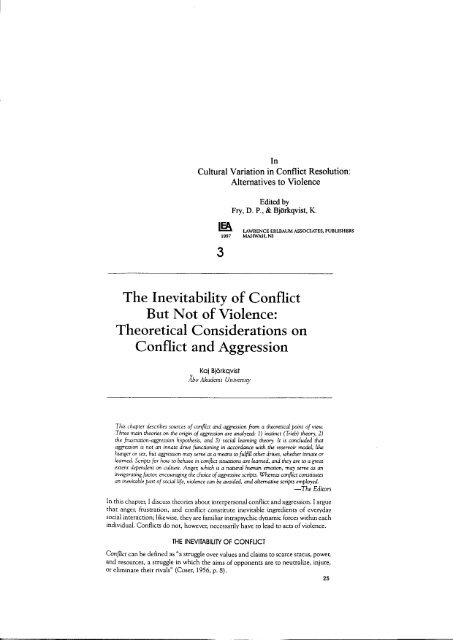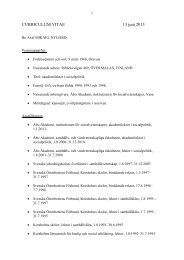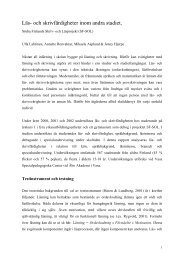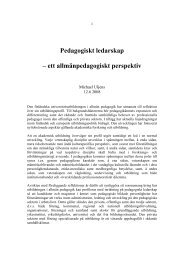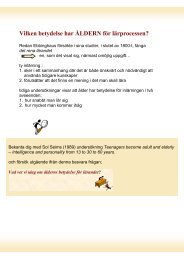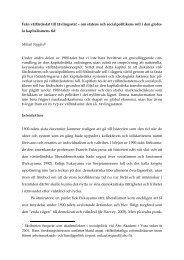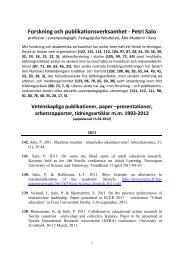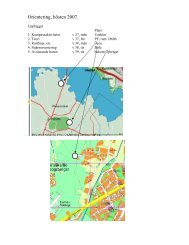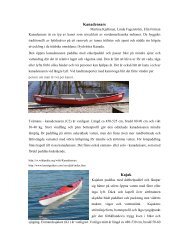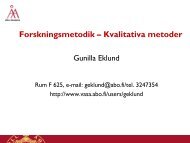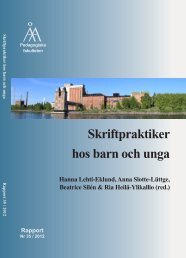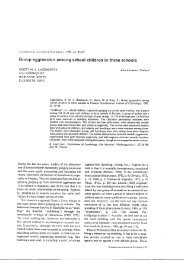Theoretical Considerations on Conflict and Aggression
Theoretical Considerations on Conflict and Aggression
Theoretical Considerations on Conflict and Aggression
You also want an ePaper? Increase the reach of your titles
YUMPU automatically turns print PDFs into web optimized ePapers that Google loves.
InCultural Variati<strong>on</strong> in C<strong>on</strong>flict Resoluti<strong>on</strong>:Alternatives to ViolenceIEAEdited byFry, D.P., & Bj0rkqvist, K.H LAWRENCE ERLBAUM ASSOCIATES, PUBLISHERS1997 MAHWAH,NJ?The Inevitabilitv of C<strong>on</strong>flictBut Not of Violence:<str<strong>on</strong>g>Theoretical</str<strong>on</strong>g> <str<strong>on</strong>g>C<strong>on</strong>siderati<strong>on</strong>s</str<strong>on</strong>g> <strong>on</strong>C<strong>on</strong>flict <strong>and</strong> Aggressi<strong>on</strong>KojBjorkqvistADO hRAAeml Unt|eEtryTlris chapter descibes sources of cuflict <strong>and</strong>, aggressi<strong>on</strong> t'rom a theoretical point of vieu.Three main theorbs <strong>on</strong> the oigin of aggressi<strong>on</strong> are analyTed: I) irurinct (Trieb) rheorl, 2)rhe fr*stran<strong>on</strong>-agrcssi<strong>on</strong> hypotfusu, <strong>and</strong>. 3) socia) Ieaming rheory. h is c<strong>on</strong>clu.d.ed thataggressi<strong>on</strong> is not an innate dive functicrning in accord.ance sith the reservoir nodel, likchunger or sex, but aggressi<strong>on</strong> ma\ serue as dme@rs to fulfll other drives, whetJvr innate orIzamed. Scnps for hru to behaue in c<strong>on</strong>flict siuati<strong>on</strong>s are leamed., atd tJvy are to a geatextena depend.ent <strong>on</strong> cuhure. Angel which is a natural human ernoti<strong>on</strong>, 'rra.J serve as aninvtgorating facmr, mcouraging the choice of aggressiue scipu. Wereas c<strong>on</strong>flict c<strong>on</strong>stitutesan ineviable part of socialife, violence can be avoided, <strong>and</strong>. ahemotive scipts employed.-Thc EditorsIn this chapter, I discuss theories about inrerpers<strong>on</strong>al c<strong>on</strong>flict <strong>and</strong> aggressi<strong>on</strong>. I arguethat angeq, fruscrati<strong>on</strong>, <strong>and</strong> c<strong>on</strong>flict c<strong>on</strong>srirure inevitable ingredients of everydaysocial interacti<strong>on</strong>; Iikewise, they are familiar intrapsychic dynamic forces wirhin eachindividual. C<strong>on</strong>{lica do nor, however, necessarilv have to lead to acts of violence.THE INEVITABILITY OF CONFLICTC<strong>on</strong>frct can be defined as "a struggle over values <strong>and</strong> claims to scarce status, powe!<strong>and</strong> resources, a struggle in which the aims ofopp<strong>on</strong>ents are to neutralize, injure,or eliminare their rivals" (Coser, 1956, p. 8).25
26 BlorkqvislThere are rwo basically different views <strong>on</strong> rhe necessiry or inevitabiliry, ofc<strong>on</strong>flicr. According ro <strong>on</strong>e view, c<strong>on</strong>flict is an aberrati<strong>on</strong> in sociery a kind of socia[parhology (Pars<strong>on</strong>s, 1951; Smelser, 1962). C<strong>on</strong>flicts can be elinrinated by giving allpeople involved what they need. C<strong>on</strong>flict is, in accordance with this view, alwaysdysfuncti<strong>on</strong>al <strong>and</strong> does not facilitate evoluti<strong>on</strong> or improvement, neicher of socieryas a whole nor of relati<strong>on</strong>s between individuals. C<strong>on</strong>flicr is nor an inevitableingredient of human life.According to the other point of view, c<strong>on</strong>flicts are inevitable by-products ofhuman interacti<strong>on</strong> (Coser, 1956). C<strong>on</strong>flicrs are c<strong>on</strong>sequences of the impossibiliryof always giving all people involved what they want.Desire <strong>and</strong> needs are not identical, <strong>and</strong> rhe facr that people cannot get all rheywanr does not automatically <strong>and</strong> in all cases inrply that they do not get what cheyneed. Rubin, Pruitt, <strong>and</strong> Kim (1994, p. 5) accordingly described c<strong>on</strong>flicr in morecareful terms, as "perceived divergence of incerest, or a belief that rhe parties'current aspirati<strong>on</strong>s cannor be achieved simultaneously."Coser ( 1956) is of the opini<strong>on</strong> rhac c<strong>on</strong>flicr, alrhough inevitable, is not inherentlypathological or always necessarily dysfuncti<strong>on</strong>al. On a short-cerm basis, a c<strong>on</strong>flictnlay seem dysfuncti<strong>on</strong>al, but <strong>on</strong> a l<strong>on</strong>g-term basis, it nray be functi<strong>on</strong>al <strong>and</strong> lead toimprovement of a sociecy in questi<strong>on</strong>. Ly<strong>on</strong>s (1993) also suggested thar c<strong>on</strong>fiictoften can be a c<strong>on</strong>srructive force in social life. The issue offuncti<strong>on</strong>aliry though,is epistenrologically problematic, <strong>and</strong> based <strong>on</strong> post hoc analysis.Levi-Strauss (1958) suggesred char c<strong>on</strong>flicrs ofdifferenr kinds are latent in everyculture, <strong>and</strong> the reas<strong>on</strong> why norms are formed is to prevent latent <strong>and</strong> potentialc<strong>on</strong>flicts. Norms are ritualized ways of h<strong>and</strong>ling c<strong>on</strong>flicr. Nornrs wirh respect toclothing may serve as an example: For instance, by c<strong>on</strong>cealing genitals, sexualexcitati<strong>on</strong> caused by visual srimulati<strong>on</strong> is reduced, <strong>and</strong> sexual c<strong>on</strong>flict ro a greatextent is avoided.There are norms for how to dress in a large variery of societal roles, a factfacilitating the preservati<strong>on</strong> of these roles. Human speech also is highty ritualized<strong>and</strong> regulated by norms; in fact, every aspect of communicati<strong>on</strong> <strong>and</strong> social life hasnorms of its own. Individuals who do not follow nornls are regarded as deviant <strong>and</strong>,if central <strong>and</strong> important norms are violared, rhe individual in questi<strong>on</strong> may bepunished. Every sociery has rules of eciquecte, rhe neglect of which leads tosancti<strong>on</strong>s. Preliterate people have sysrems of social c<strong>on</strong>trol, although they do notperhaps have a wricren law.l-evi-Srrauss' view may be compared to Freud's (19]0/1948) opini<strong>on</strong> <strong>on</strong> norms<strong>and</strong> culture, presented in his book Das lJnbehagen in der Kultur lCivilizati<strong>on</strong> <strong>and</strong> itsDisc<strong>on</strong>tents]: According to Freud, the internalizati<strong>on</strong> of norms into an intrapsychicsuperego is the result ofthe clash between the pleasure-principle <strong>and</strong> the realiryprinciple.Humans cannot get everyching they want. Taken as a whole, culturefacilitates human well-being, but culture also puts limitad<strong>on</strong>s <strong>on</strong> the individual.The positi<strong>on</strong> raken in this chapter is rhat c<strong>on</strong>flicts really are inevirable. However,rhey should not in all cases be regarded as dysfuncti<strong>on</strong>al, or as a kind of socialpathology. C<strong>on</strong>flicts are of many different rypes, some functi<strong>on</strong>al, some dysfunc-
3. Invevifobilitv of C<strong>on</strong>fllcf Bul Not ol Vlolence 27ri<strong>on</strong>al. Some c<strong>on</strong>fliccs are harmful, but, in some cases, c<strong>on</strong>flicts may improve society<strong>and</strong> social relati<strong>on</strong>s <strong>on</strong> a l<strong>on</strong>g-ternr basis.AGGRESSION AND ANGERViolence <strong>and</strong> aggressi<strong>on</strong> are related c<strong>on</strong>cepts, often used syn<strong>on</strong>ymously in everydaylanguage; they are not, however, identical but rather partly overlapping c<strong>on</strong>cepts,violence being <strong>on</strong>ly <strong>on</strong>e form of aggressi<strong>on</strong>. The emori<strong>on</strong> of anger also is oftenmistakenly used as a syn<strong>on</strong>ym ofaggressi<strong>on</strong>. Aggressi<strong>on</strong> is an act, not an inner stare.The emoti<strong>on</strong> ofanger is often (bur not always) a precursor ofaggressi<strong>on</strong>.Buss (1961, p. 1) defined aggressi<strong>on</strong> as "a resp<strong>on</strong>se that delivers noxious sdmuliro anorher organism." That definiti<strong>on</strong> does not exclude harm delivered to anotherpers<strong>on</strong> or organism unintenti<strong>on</strong>ally. IfBuss'definiti<strong>on</strong> is taken literally, hitting <strong>and</strong>injuring another pers<strong>on</strong> accidentally by car would be an aggressive act.Authors ofa behaviorist orientati<strong>on</strong> have rried to avoid references to inner statesor inrenti<strong>on</strong>s, bur rhey use instead ternrs such as goal'direcri<strong>on</strong>. Dollard, Doob,Miller, Mowrer, <strong>and</strong> Sears (1939, p.7) defined aggressi<strong>on</strong> as "an act whosegoal-resp<strong>on</strong>se is injury to an organism (or organism-surrogate)." Bar<strong>on</strong> (1977' p. 7)defined aggressi<strong>on</strong> as "any form ofbehavior directed toward the goal ofharming orinjuring another living being who is nrotivated to avoid such fieatment."Aggressi<strong>on</strong> here is defined as an incenci<strong>on</strong>al act, carried out with the purpose ofcausing physical or mental pain to another individual or organisn (see alsoBjorkqvisr & Nienreld, 1992). In order to be regarded as painful, the act must be ofa kind that the object is motivated to avoid. If the perperaror does not succeed inhis or her intenti<strong>on</strong>s, <strong>and</strong> no injury occurs, the act may still be regarded as aggressive.There is experimental evidence (Holm, 1985; Bjorkqvist, Lindstrcjm, Pehrss<strong>on</strong>,1989) that people pay attenti<strong>on</strong> !o at least the following four facrors when theyattribute aggressiveness to an act: 1) its intenti<strong>on</strong>aliry, Z) the extenc of injury orharm, 3) the reas<strong>on</strong> (e.g., offensive attack vs. defense), <strong>and</strong> 4) the method.While aggressi<strong>on</strong> is a kind of behavior or an act, aggressiveness is the inclinati<strong>on</strong>to inrenri<strong>on</strong>ally behave in a harmful way. One may distinguish becween situati<strong>on</strong>allydetermined'state aggressiveness' <strong>and</strong> the more profound'crait aggressiveness,' thatis, the inclinati<strong>on</strong> to behave aggressively in a variery of situad<strong>on</strong>s, a pers<strong>on</strong>alirytrait).Ic is noteworthy that intenti<strong>on</strong>al harmful behavior may be carried out withoucany feeling of anger whatsoever, so to say, in cold blood. It is comm<strong>on</strong> practice todifferentiate between emoti<strong>on</strong>ally determined agressbn, originating from anger, <strong>and</strong>instrumental aggressi<strong>on</strong>.ln the latter case, the aggressive behavior is <strong>on</strong>ly an instrumentfor the accomplishment of a speci{ic goal. Feshbach (1964), who was the firstto make the distincti<strong>on</strong> between rhese two, used the label hosole aggressi<strong>on</strong> for theemoti<strong>on</strong>ally determined category whereas Fraczek (1989) referred to it as emo[o-[enic aggressi<strong>on</strong> These rwo rypes of aggressi<strong>on</strong> do noc necessarily exclude <strong>on</strong>eanother, <strong>and</strong> aggressive acts are, indeed, in many cases, a mixrure ofboth. But, as
28 EiorkovisiLagerspetz (1984) suggested, rhe mosr comm<strong>on</strong> emoti<strong>on</strong> of soldiers in war is nocanger, but fear. Anger is noc a prerequisite for aggressr<strong>on</strong>.Accordingly, it is important ro keep in mind that anger <strong>and</strong> aggressi<strong>on</strong> arec<strong>on</strong>ceptually different. This distincti<strong>on</strong> is of special imporrance when we discusswhether violence is an inevitable outcome of c<strong>on</strong>flict. Although anger may lead roaggressive behavior, it does not necessarily do so in every case. Anger is a natural,invigorating emoti<strong>on</strong>, biologically geared from the lin'rbic system, especially fromthe hypothalamus <strong>and</strong> the amygdala (Herbert, 1989); it is an emori<strong>on</strong> every<strong>on</strong>e hasexperienced <strong>and</strong> will experience, perhaps <strong>on</strong> a daily basis. The well-known crossculturalsrudy <strong>on</strong> n<strong>on</strong>verbal expressi<strong>on</strong>s ofemori<strong>on</strong>s by Ekman <strong>and</strong> Friesen (1971)suggesthat rhe emoti<strong>on</strong> of anger is similarly displayed in different cultures in analmost universal fashi<strong>on</strong>. How we deal with our anger, however, whether we willutilize its lorce for aggressive or c<strong>on</strong>srrucrive purposes, is learned.THE ORIGIN OF AGGRESSIONThe history of psycl-rology has wirnessed three nrain theories about rhe origin ofaggressi<strong>on</strong>: 1) instinct rheory, claiming that aggressi<strong>on</strong> is an innare drive, Z) thefrustrari<strong>on</strong>-aggressi<strong>on</strong> hypothesis, <strong>and</strong> 3) the social learning rlleory of aggresskn. Idiscuss rheir advantagcs-<strong>and</strong> problems----<strong>on</strong>e by <strong>on</strong>c.Instinct TheoryThe nrost well-known prop<strong>on</strong>ents of the theory (Signrund Freud, <strong>and</strong> K<strong>on</strong>radLorenz) have written ir-r Gernran, <strong>and</strong> the so callcd instinct the<strong>on</strong>i accordingly,should rather be labeled the Tiieb-theory because there is a vasr differcncc berweenthe Cerman Tneb <strong>and</strong> the English instinct (Cerrnan: Instinftt). \Vhen Freud's workwas translated into English, the rranslators wr<strong>on</strong>gly chose the word insrinct ir-rsteadof drive, which would have been the erynrologically correcr equivalenr. This misrakehas caused enornlous c<strong>on</strong>fusi<strong>on</strong> wirhin the field of psychology of nrotivari<strong>on</strong>, <strong>and</strong>the damage cannot bc und<strong>on</strong>e.The closest way ro describe whar Tileb really nreans is rhar ic implies an innatc(Latin in natus: present ar birrh) drive, funcri<strong>on</strong>ing in accordance wirh rhe so cailedreservoir model. The drivc is triggered by internal rarher rhan external srimuli,examples being the hunger, thirst, <strong>and</strong> sexual drives. Tl're internal pressure plays amore central <strong>and</strong> imporranr role than external stimulati<strong>on</strong>, <strong>and</strong> it determines thestrength of rhe drive, although external stimuli may c<strong>on</strong>tribute. The reservoir nrodelsuggests rhar in the same way as a reservoir slowly fills wirh water, increasing thepressure in the rank, drive srrer-rgth also c<strong>on</strong>tinuously increases over tinre, if theneed is nor fulfilled. Tl-re l<strong>on</strong>ger rhe rime since lasr fulfillment, rhe greater rhepressure.lf the theory were correcr <strong>and</strong> aggressi<strong>on</strong> really is a ?reb in the suggested scnse,then humans would feel an evcr-increasing drive toward being aggressive, alsowithout exrernal frustrati<strong>on</strong>. The pressure would so<strong>on</strong>er or lacer force each <strong>on</strong>e ofus to carry our acrs of aggressi<strong>on</strong>.
3. Invevilobilltv of C<strong>on</strong>flict Buf Nol of Vlolence 29Freud originally stated rhat there existed <strong>on</strong>ly <strong>on</strong>e basic drive in humans, thetibido or Eroi, fto* which other morivari<strong>on</strong> is derived (Freud, 1920/1940). Later'after experiencing rhe horrors of\0orld \var I, he canre to che c<strong>on</strong>clusi<strong>on</strong> that therealso must e*ist *iihin man an opposite, desructive drive, which he labeled Thanatosafter rhe Greek god ofdearh (Freud, 1910/1948). The English-language literaturehas labeled this drive the death instinct.Freud was involved in corresp<strong>on</strong>dence with Albert Einstein, in which theydiscussed whether tl-ris proposed destructive drive really existed, <strong>and</strong> ifit did, woutdrhis drive explain *hy humar.r, so easily ger involved in warfare (Einstein& Freud,l933llg7z). Emsrein denied the existence of Thanatos, but Freud held a morepessimistic view According to him, hunrans have indeed an innate drive towarddestructi<strong>on</strong>, <strong>and</strong> therefore, warfare cannot be avoided'A circumstance lirtle known or at least seld<strong>on</strong>r described in the literature is thatFreud was of the opini<strong>on</strong> rhat the death ?ieb, Thanatos, primarily is self-descructive'directed inwards io*ard people themselves, <strong>and</strong> rhat outward aggressi<strong>on</strong> o.ly is achan1rele derivari<strong>on</strong> fr<strong>on</strong>t ic. Eros a1d Thar-ratosymboli;ed to him the <strong>on</strong>goingstruggle berween thc wish for life <strong>and</strong> the wish fbr death, within eacl'r individual'ir1,.hor,.,"lyrt, afrer Freud found rhe idea of an innate self-destructive drivedifficulr to rec<strong>on</strong>cile <strong>and</strong> Hartmann, Kris, <strong>and</strong> Loewenstein (1949) suggested thatthere is, indeed, a drive roward destrucri<strong>on</strong> rvithin humans, but the primarydirecCi<strong>on</strong> of ti.ris drive is outward aggressi<strong>on</strong>, uot inward self-destructi<strong>on</strong>. Thrsviewpoint has been comm<strong>on</strong>ly accepted within psychoanalysis ever since' That is'the noti<strong>on</strong> of ar.r innate aggressive drive stems, in a strict settse, frotn Hartmann,Kris, <strong>and</strong> l-,oewensreiu, l'Iot frotn Freud.Erhologist K<strong>on</strong>rad Lorenz also suggested the existence of an innare' aggressivedrive in hii book On Aggressi<strong>on</strong> ( 1966). The exacc ftanslati<strong>on</strong> of the German originalname Das Sogen<strong>on</strong>,l,. Bor. (Lorenz, 1963) woutd be "The So-Catled Evi[," revealingLorenz's viewpoinr that aggressi<strong>on</strong> is not necessarily bad. It is obvious from Lorenz'spresentari<strong>on</strong> ihat he rhoughr this drive to functi<strong>on</strong> in accordance with the pre'viously menri<strong>on</strong>ed reservoir moclel. M<strong>on</strong>ragu (1976, p. 92) describes it as a "hydraulicnrodel." Lorenz (1966) suggested that the best way for hunankind to avoidviolence is ro find vicarious ourlets for this drive, such as the viewing of aggressivesporrs-a kind of catharsis hypothesis (Feschbach, 1955). The serious problenr ofulol"n." ant<strong>on</strong>g soccer fx15-;se6sg1 hooliganism"-is a real-life refutati<strong>on</strong> of thishypothesis, n, *. th" findings ofincreased aggressiveness after violent film viewing(e.g., Gorans<strong>on</strong>, 1970; Huesmann & Er<strong>on</strong>, 1986).Tl.re instincr, or Trieb rheory, should thus be regarded as refuted: The need toaggress is not an innate drive comparable to hunger, thirst' or sex, functi<strong>on</strong>ing inaccordance with the reservoir model. If tltat were the case, every<strong>on</strong>e of us wouldfee[, wirhout exrernal stinruli or frustrati<strong>on</strong>, an ever-incteasing drive to bec<strong>on</strong>leaggressive, perhaps a need to go out <strong>and</strong> hit some<strong>on</strong>e about <strong>on</strong>ce a week, in orderto have the drive fulfilled' This is certainly not the case.There is, however, at least <strong>on</strong>e circuntstance ofbiological nature that may havea str<strong>on</strong>g tenclency to lead nten <strong>and</strong> w<strong>on</strong>ren intO interpers<strong>on</strong>al c<strong>on</strong>flict: the naturalemori<strong>on</strong> of angcr, cxperienced when <strong>on</strong>e is frrrstrated. The abiliry to get angry has
30 Biorkqvislprobably served as an invigoraring mediaror enhancing the tendency towardsaggressive behavior.Subhuman primates show borh terrirorial <strong>and</strong> hierarchical behavior (Mas<strong>on</strong>&Mendoza, 1993). Humans display territorial <strong>and</strong> hierarchical parrerns of behavror,too, but whether chese reflect innate drives or learned behavior is a matter ofdispute(Knauft, 1994). Aggressi<strong>on</strong> is often useful <strong>and</strong> somerimes even necessary in thedefense of <strong>on</strong>e's territory. In prehistoric times, individuals who were noc able to learnaggressive behavior may nor have been able to survive <strong>and</strong> propagare.Mammals living in social groups have hierarchies or "pecking orders" (Tinbergen,1951). The studies by Goodatl ( 1991) <strong>on</strong> chimpanzees living in rhe wild presentlively descripti<strong>on</strong>s ofviolence berween chimpanzees, as a c<strong>on</strong>sequence ofhierarchicaldisputes. Hierarchical orders may be noced also am<strong>on</strong>g humans. These socialhierarchies are to a grear extenr sex-specific, males forming hierarchies of their own,females of their own (Bjorkqvisr &Niemelii, 1992). Individuals of rhe same sex alsohave a tendency to compete over mating partners. When rhe hierarchy wirhin agroup is known <strong>and</strong> accepted, there is litrle overt aggressi<strong>on</strong>: When the order isdisputed, aggressi<strong>on</strong> increases.The c<strong>on</strong>clusi<strong>on</strong> derived is that aggressi<strong>on</strong> is nor an innare drive in itsel{, bur rrmay serve as a means to fulfill ocher drives, wherher innare or learned. Aggressr<strong>on</strong>may also have been necessary ro arrain viral resources in periods <strong>and</strong> geographicalareas where resources have been scarce. The emori<strong>on</strong> of anger serves as anenergizing power, rendering violent soluti<strong>on</strong>s of c<strong>on</strong>flicts more likely than n<strong>on</strong>violenc<strong>on</strong>es (but sdll not inevirable).The Frustroti<strong>on</strong>-Aggressi<strong>on</strong> HypothesisThe sec<strong>on</strong>d (chr<strong>on</strong>ologically speaking) influer.rtiaI theory abour the origin of aggressi<strong>on</strong>is the frustrati<strong>on</strong>-aggressi<strong>on</strong> hypothesis, presented in rhe work Ftustrati<strong>on</strong> <strong>and</strong>Aggressi<strong>on</strong> by Dollard, Doob, Miller, Mowrer, <strong>and</strong> Sears (1939). According to rhishypothesis, the source ofaggressi<strong>on</strong> is always a frustrati<strong>on</strong> ofsome kind, whether arecent, situati<strong>on</strong>ally relevant frusrrati<strong>on</strong> or a previous <strong>on</strong>e (e.g., stemming from thechildhood). In rhe latter case, <strong>on</strong>e could speak ofbottled-up frustrari<strong>on</strong>s, leadrngto an aggressive pers<strong>on</strong>aliry a tendency to behave aggressively in a variery ofsituati<strong>on</strong>s.The original versi<strong>on</strong> of the hyporhesis, as presenred by Dollard, et al. (1939),stated that frustrati<strong>on</strong> always caused aggressi<strong>on</strong>, <strong>and</strong> thar aggressive behavior wouldnever appear withour previous frustrati<strong>on</strong> (i.e., there is a direct, necessary c<strong>on</strong>necti<strong>on</strong>between che rwo).This argument has several problems. The firsr difficulry is epistenrological:Inductive inferences about causal relati<strong>on</strong>ships, like the <strong>on</strong>e between frusrati<strong>on</strong><strong>and</strong> aggressi<strong>on</strong>, are impossible ro prove (Poppea 1959).Sec<strong>on</strong>d, frustrati<strong>on</strong> may well lead to other forms of behavior than aggressi<strong>on</strong>, forinstance depressi<strong>on</strong>. Or, frustrad<strong>on</strong>s may inspire the individual ro c<strong>on</strong>srrucnveproblem-solving. Frustrati<strong>on</strong> often has other c<strong>on</strong>sequences than aggressi<strong>on</strong>.
3. Invevilobillly of C<strong>on</strong>ltlct But Nol of Vlolence3lOnly rwo years after the publicati<strong>on</strong> o( Frustratian <strong>and</strong> Agressbn, <strong>on</strong>e of ircaurhors, Neal Miller wrote an article (1941) in which he revised his opini<strong>on</strong>.According to his revised versi<strong>on</strong> ofthe hypothesis, the c<strong>on</strong>necti<strong>on</strong> between frustrati<strong>on</strong><strong>and</strong> aggressi<strong>on</strong> is not necessary but likely. Frustrati<strong>on</strong>s may have c<strong>on</strong>sequencesother than aggressi<strong>on</strong>.Fraczek (1989) has suggested chat frusrati<strong>on</strong>s are not a necessary prerequisiceof aggressi<strong>on</strong>, <strong>and</strong> individuals may be aggressive out of pure habit. He coined thercrm habitu.al agressi<strong>on</strong>, to describe this pattern of behavior. He did not, however,menti<strong>on</strong> habitual aggressi<strong>on</strong> in c<strong>on</strong>necti<strong>on</strong> with the frustrati<strong>on</strong>-aggressi<strong>on</strong> hy'pothesis, but the existence ofhabitual aggressi<strong>on</strong> would as such imply a refurati<strong>on</strong>of the frusrad<strong>on</strong>-aggressi<strong>on</strong> hypothesis, even in its revised versi<strong>on</strong> (Miller' 1941).It is, however, possible that aggressi<strong>on</strong> may be caused by frustrad<strong>on</strong>, but also byhabiruati<strong>on</strong>; <strong>and</strong>, fruscrati<strong>on</strong> likewise nray have c<strong>on</strong>sequences other than aggressi<strong>on</strong>,as suggested by Miller (1941). In thar case, a sec<strong>on</strong>d, rarher diluted, revisi<strong>on</strong>of the frustrati<strong>on</strong>-aggressi<strong>on</strong> hypothesis-including multiple causes of aggressi<strong>on</strong>,<strong>and</strong> multiple effects of frustrati<strong>on</strong>-n'right be c<strong>on</strong>sidered acceptable. This versi<strong>on</strong>was presented in an article by Bjorkqvist (1990).Figure 3.1 presents the frusrrati<strong>on</strong>-aggressi<strong>on</strong> hypothesis, covering rhe modifrcati<strong>on</strong>suggested by Milter (1941), as well as rhe modificati<strong>on</strong> presented byBjorkqvist (1990).In 1989, I asked Neal Miller whether the interpretati<strong>on</strong> of Miller's (1941) articlejust presented was correct. Miller's answer was "yes," but rhat he now also would-->\--
32 Bi6rkqvislbe ready to accept that orher causes of aggressi<strong>on</strong> than previous fiustratio^ mightexist (N. Miller, pers<strong>on</strong>al communicati<strong>on</strong>, June, 1989).Sociol Leorning TheoryThe third main theory <strong>on</strong> rhe origin of aggressive behavior, social learning theory,dominated psychological chinking during rhe 1960s <strong>and</strong> 1970s, but ir seems nowto be giving way ro more cognirively oriented hypocheses. According ro it,aggressi<strong>on</strong> is not an innare drive, but ir is learned. The main prop<strong>on</strong>ent of thischeory has been Albert B<strong>and</strong>ura (e.g., B<strong>and</strong>ura,1973). The theory has focusedmainly <strong>on</strong> rhe issue of how aggressi<strong>on</strong> is learned, <strong>and</strong> especially <strong>on</strong> observari<strong>on</strong>allearning. The [earning of aggressi<strong>on</strong> occurs by c<strong>on</strong>diri<strong>on</strong>ing. The c<strong>on</strong>diti<strong>on</strong>ing maybe direct or vicarious; ic is direct when the individual learns rhat aggressi<strong>on</strong> pays,by a kind of trial-<strong>and</strong>-error srrategy, or through instrumenral c<strong>on</strong>diri<strong>on</strong>ing. Notethat the principle of rrial-<strong>and</strong>-error described by rhe associaci<strong>on</strong>ist Thorndike(1906) is in facr identical wirh rhe principle of instrumenral c<strong>on</strong>diri<strong>on</strong>ing asproposed by rhe behaviorist skinner (191s). social learning cheory suggests thatlearning fiom models should be regarded as vicarious c<strong>on</strong>diti<strong>on</strong>ing, (i.e., learningoccurs by warching models attaining rheir goals through aggressive means). If rhemodel succeeds, it has the effect of a positive vicarious reinforcemenr <strong>on</strong> theviewer.The c<strong>on</strong>cept of vicarious c<strong>on</strong>diti<strong>on</strong>ing appeared the first rime ir.r rhe book socrarI*arning <strong>and</strong>lmitati<strong>on</strong> by Miller <strong>and</strong> Dollard (1941), who atre.rpted ro explain allkinds of learning, also rhe difficult issue of learning fr<strong>on</strong>r nrodels, in behavioristermsas kinds of c<strong>on</strong>diti<strong>on</strong>ing.I basically agree with B<strong>and</strong>ura's theory, the <strong>on</strong>lv serious criticism beins rhat hewas nor able ro disrance himself enough from behaviorisr lea.ring rheory. In thesame vain as Miller <strong>and</strong> Dollard (1941), he presenred imicari<strong>on</strong> as if learning frommodeis occurs <strong>on</strong>ly if the model is successful, ie., rewarded (B<strong>and</strong>ura, r9z3). It rsnot certain whether he really was of this opihi<strong>on</strong>, but rhis is the inrpressi<strong>on</strong> thereader gets.I have suggested in other articles (Bjdrkqvist&Osrerman, 1992; Bjorkqvist, rnpress) that the learning of aggressi<strong>on</strong> from models cannor be explained i' rerms ofvicarious c<strong>on</strong>diti<strong>on</strong>ing <strong>on</strong>ly. At a minimum, the following four facrors are imporranr:1) the degree of similaricy between the model situati<strong>on</strong> <strong>and</strong> the acrual siruati<strong>on</strong>, z)the degree of identificati<strong>on</strong> berween acror <strong>and</strong> model, 3) rhe success or failure ofthe model (vicarious c<strong>on</strong>diti<strong>on</strong>ing), <strong>and</strong> 4) the amounrofexposure ro the modelsituati<strong>on</strong>.Heavy exposure to an aggressive model (e.g., a father) who is unsuccessfur <strong>and</strong>does not reach his goals by aggressive behavior may as such be an influence sff<strong>on</strong>genough to cause imitati<strong>on</strong>, if the child has no orher scripts of behavior (Schank&Abels<strong>on</strong>, l9?7) to assimilate. Recent authors within aggressi<strong>on</strong> research (eg.,Huesmann & Er<strong>on</strong>, 1986; Bjorkqvist & Osterman, L99Z; Bjorkqvist, in press)suggested thac cognirive theory is berter able co explain the learning ofaggressi<strong>on</strong>rhan raditi<strong>on</strong>al, behaviorist-oriented social learning rheory.
34 giorkqvisfpanzees living in the wild, reported warlike c<strong>on</strong>flicts berween groups of chinpanzees,including sysremadc ambush, ending in killings of members of the rival grtup.warfare is, according ro rhe sratemenr, a peculiar hun'ran phenomeno.t that do.snoc occur in other animals. The fact that warfare is frequenr am<strong>on</strong>g humans, thestatement suggesrs, indicares that war is a product of human culture: Language,tools, <strong>and</strong> rechnology have made warfare possible. varfare is, however, nor inevitable;rhere are cultures that have nor engaged in warfare, whereas orher have hadwars fiequenrly. Further, there are cultures which have engaged in warfare frequentlyduring certain periods, although they have been living in peace wirh rheirneighbors at orher times (The seville staremenc <strong>on</strong> Molence, r986ii989).People used to jusrifo slavery <strong>and</strong> sexist dominati<strong>on</strong> by claiming rhat they werebiological <strong>and</strong> inevitable. These claims were found ro be unrrue, slavery was ended,<strong>and</strong> the world communicy is working ro srop racial <strong>and</strong> sexisr dominari<strong>on</strong>. In chesame fashi<strong>on</strong>, the signarories of rhe seville staremenr suggesc, rhe world is nowfooling irself by believing thar war <strong>and</strong> violence cannot be ended because rheyc<strong>on</strong>sdture a parr ofour biological makeup.The seville Statemenr was endorsed by a number of n<strong>on</strong>governmental organrzati<strong>on</strong>s,am<strong>on</strong>g them Unired Nari<strong>on</strong>s'Educati<strong>on</strong>al, sciendfic, <strong>and</strong> cultural organizati<strong>on</strong>(UNESCo). An impressive number of scientific organizari<strong>on</strong>s also haveendorsed the statement, am<strong>on</strong>g them, the American Psychological Associari<strong>on</strong>(APA)' the American Anthropological Associati<strong>on</strong> (AAA), <strong>and</strong> rhe Inrernati<strong>on</strong>alsociery for Research <strong>on</strong> Aggressi<strong>on</strong> (lsRA). The iniriarive ro drafr rhe sevilleStatenrent was, in fact, made by individual ISRA menrbers.The validiry of the seville srateme'r has noc g<strong>on</strong>e unquesti<strong>on</strong>ed, <strong>and</strong>, witnrnISRA, there were debaces about whether the sociery should endorse the sratemenror not.\Uhen the council of Representarives of the ApA vored to endorse rhe Sevillestatement in 1987, the Board of scienrific Affairs emphasized that, in their opini<strong>on</strong>,it is not a quesri<strong>on</strong> of a scienrific sraremenr <strong>on</strong> the issue of specific inheriredbehavioral traits. Rather, it is a social sraremenr designed ro eliminare unfoundedstereorypic thinking <strong>on</strong> the inevirabiliry of war.coNcLUstoNsIn summary aggressi<strong>on</strong> is nor an innate drive (or instinct) per se, funcri<strong>on</strong>ing inaccordance with the reservoir model, like drives to satisfii hunger, rhirsr, <strong>and</strong> ie*.Throughout human evoluti<strong>on</strong>ary history incerpers<strong>on</strong>al "ggr.rrio., may have had,however, a facilitating <strong>and</strong> mediating role in the fulfrllmeniof orher drives, whetherthese are innate or learned, such as territorial <strong>and</strong> hierarchical drives, <strong>and</strong> strugglesfor getting access ro mating partners. Aggressive behavior has cerrainly playJanevoluti<strong>on</strong>ary role for survival, especially when resources have been scarce. Althoughscripts of aggressive behavior are learned, n6s Innsgs-nobody knows how ro fighrwithout training or modeling-it may be argued thar rhe abllicy ro learn aggressi<strong>on</strong>has been useful for survival, <strong>and</strong> narural selecti<strong>on</strong> for rhe ability to get angry whenvital interests are threa[ened may have occurred.
3. lnvevitobillty ot C<strong>on</strong>lllcl Bul Not of Vlolence 35The emod<strong>on</strong> of anger is often a predecessor of aggressive behavior, with angerserving as an invigoracing factor, making aggressive behavior more likely. Angershould definitely not be regarded as unnatural; it is an emoti<strong>on</strong> as natural as anyother. Anger however, does not have !o lead to violence. There is not proof of theexistence of any biological factor making violent soluti<strong>on</strong>s of c<strong>on</strong>flicts inevitable.It is especially important ro keep in mind that forms of aggressive behavior arelearned, not innate. While every child has innate programs for laughing, crying,crawling, <strong>and</strong> walking, there is no innace programming for clenching fists, beacing,kicking, or shooting others. These parrerns or scripts of behavior are learned,especially by watching aggressive models. This learning is more likely to occur in asociery acceptive of <strong>and</strong>, even more likely, in <strong>on</strong>e glorifring aggressi<strong>on</strong>. If modernwarfare is a c<strong>on</strong>sequence ofhuman culture rather than ofhuman nature, perhapsculture is also the best cure against it. As the Seville Scarement put it, che speciesrhat invented warfare should also be capable of invendng peace. What is needed,above all, is a change in the general atdtude rowards violence.REFERENCESBan,lura, A. (1973). Aggressioru- A sxialleaming arol1sis. Englew<strong>on</strong>, R. A. (197i). Hurun Aggress<strong>on</strong>- Ncw York: Plenum.Batcs
BlorkqvisfFreud, S. (1940). Csamruhz Weilc [Collected works] (Vol. l3). L<strong>on</strong>d<strong>on</strong>, Engl<strong>and</strong>: lmago.(Origrrul work published 1920)Freud, S. (1948). GsamkeWe*e lCollected works] (Vo[. 14). L<strong>on</strong>d<strong>on</strong>: lmago. (Original mrkpubtished 1930)Coqlall, J. (1991). Throug! a uindru: 30 lears with rhe chinpanzea of Gmbe. Bost<strong>on</strong>, MA:Hought<strong>on</strong> Mifflin.Gorans<strong>on</strong>, R E. (1970). Media violence <strong>and</strong> aggressive behavior: A review of expenmentalresearch. InL.Berkowitz (Ed.),AdwuinuPei'mtr,lsxialpslcholog (pp. 1-31).NewYork:Academic.Crmbel,J., &Hinde, R. (Eds.).(1989).Asgrssi<strong>on</strong><strong>and</strong>warTheirbbbgical<strong>and</strong>.socazlbcs.NewYork: Cambridgc University Press.Hartmann, H., Kris, E., & L*wenstein, R. (1949). Nores <strong>on</strong> rhe rheoryof aggressi<strong>on</strong> PsychoanafticSudl of rlv ChiA, 3,9-36.Herbert, J. (1989). Thc physiology of aggrcssi<strong>on</strong>. In J. Groebel & R. Hinde (Eds.), Aggrasbn <strong>and</strong>uar: Their bbbgaol atd, srcial basa (pp. 58-71). New York: Cambridge Universiry Prcss.Holm, O. (1985). Four deteminants of perceiued aggressbn <strong>and</strong> a fourstep dt ibutin rnodel. Umcl.Sweden: Umcl Univcrsity Press.Hucsmann, R. L., & Er<strong>on</strong>, L. (Eds.).(1986).?levubn <strong>and</strong>. tlle agrusive chiH: A cross-rccio.ujcomparis<strong>on</strong>. Hillsdalc, NJ: Lamencc Erlbaum Associatcs.Knauft, B. M. (1994). Culture <strong>and</strong> cooperati<strong>on</strong> in human evoluti<strong>on</strong>. In L. E. Sp<strong>on</strong>scl & T Gregor(Eds.), The aruhropobgy of pwe <strong>and</strong>rcnvblsae (pp.37-67). Boulder, CO: Lynnc-Rienncr.Lagerspctz, K. M. J. (1984). Psychology <strong>and</strong> its fr<strong>on</strong>tiers. In K. M. J. Lagerspetz & P Nicmi (Eds.),Psychoio6y in ke 1990' s (pp. 2344\. Amsterdam: North.Holl<strong>and</strong>.Levi-Strauss, C. (1958). Anrhrcpologb scructuralc [Sructural Anrhropology]. Paris: Pl<strong>on</strong>.Lorenz, K. (1963). Dc SogmmneB6se. ZurNaurguchidte du Agressi<strong>on</strong> [The so.calletl evi[: Onapgressi<strong>on</strong>l. Viema, Austria: Borotha Schcler-Verlag.breu, K. (1966). On Agrasbn. New York: Harcourt, Brace & World.Ly<strong>on</strong>s, D. M. ( 1993) . C<strong>on</strong>flict as a c<strong>on</strong>suuctivc forcc in social life. In W A. Mas<strong>on</strong> & S. P Mcndoza(Eds.), Parote saial c<strong>on</strong>flict (pp. 387-408). Albany, NY: State Univcrsiry of New York Press.Mas<strong>on</strong>, V. A., & Mendoza, S. P (Eds.). (199! . Pnmce social c<strong>on</strong>flict. Albany, NY State UniversiryofNew York Press.Mead, M. ( 1940). Warfare is <strong>on</strong>ly an invend<strong>on</strong>-noc a biological necessiry. Aria, XL, 402-.405.Miller, N. E. (1941). The frustrati<strong>on</strong>-aggrcssi<strong>on</strong> hlpothesis. Pslchologica! Revieu, 48, 337-342.Miller, N. E., & Dollard, J. (1941). Socialleaming <strong>and</strong> imnti<strong>on</strong>. New Haven, CI Yale UnivcrsrryPress.M<strong>on</strong>tagu, A. (1976). The rucate of humn aggressi<strong>on</strong>. New York: Oxford Universiry Press.Pars<strong>on</strong>s, T (1951). The sxial sysrm. New York: Free Press.Popper, K. (1959). The logic of scientific dLscueris. L<strong>on</strong>d<strong>on</strong>, Engl<strong>and</strong>: Hutchiru<strong>on</strong>.Rubin, J. 2., Pruitr, D. G., & Kim, S. H. (1994). Social c<strong>on</strong>flict: Escalan<strong>on</strong>, stalernate, <strong>and</strong> sectlqnstNew York: McCraw-Hill.Schank, R, &Abels<strong>on</strong>, R. (1977). Scriprs, phru, goak ad.urvJ.ers:ain&ing: anen4uirJ intohuntar.tkrcwledge. Hillsdale, NJ: Lawrence Erlbaum Aswiates.Seville Statement <strong>on</strong> Molence. (1989). Reprinred in J. Croebel, J. Hinde, & R. Hinde (Eds.),Agrasi<strong>on</strong> anl, uar: Theu bblogical nd social basa (pp. xxiii-xvi). New York: CambridgeUniversity Press. (Original work published 1986)Skinner, B. E (1938). The behzvior of organisms. New York: Applet<strong>on</strong>.Smelser, N. (1962). Theol of colbcrile behanw. New York: Rce Press.Thomdike, E. L. (1906). Animl intelligatce. Psychological M<strong>on</strong>ograpls, 1, No. 8.Tinbergen, N. (1951). The study ofinstinrt. Oxford, Engl<strong>and</strong>: Clarend<strong>on</strong> Press.


